There are many activities that Canadians love in the winter; there is none more Canadian than ice skating. To make it even more Canadian you ice skate on the Rideau Canal. But the world’s longest skate way was originally designed for a completely different use in mind than a key feature in Ottawa, Ontario’s Winterlude festival. Built during the same period as the First Welland Canal, the Rideau Canal addressed the concerns raised during the War of 1812, where the St. Lawerence River provided the only path for supplies to arrive in Upper Canada from Quebec City, Montreal, Halifax and England herself. Travel on the St. Lawerence in the early 19th-Century was not a quick and easy way as it is today, the large ocean-going ships could go as far as Montreal. From there the supplies were loaded onto small river craft that could navigate the river, not to mention in several places you would have to portage before being loaded onto lake boats at Prescott. And there was the threat of the American guns on the other side of the river. The direct solution would be to build small locks on the St. Lawerence River to bypass the many rapids along its route, however that could not address the security questions. It was back in 1783 a survey saw completion that would bypass the St. Lawerence using the Rideau and Ottawa Rivers turning the existing Rideau Waterway into a Canal through a series of Locks, similar to what was done to the Welland River. The 1783 survey was shelved as tensions between the United States, and England cooled off, a similar problem returned in the War of 1812. But the British victories at Ogdensburg, Chateauguay, and Crysler’s Farm ensured British control of the St. Lawerence was maintained throughout the war. But in the post-war reconstruction of Upper Canada’s defences, a second survey of the Rideau Waterway was undertaken by Lieutenant Joshua Jebb of the Royal Engineers in 1816. Jebb’s report offered two possible routes for the proposed canal; the first option was the Rideau River the second was Irish Creek. The report would have remained on a shelf at Horse Guard if it was not for the untimely death of Sir Charles Lennox, then Governor-General of British North America. Governor Lennox had been travelling through Upper Canada, but the rough backwater roads and trails proved to be his death as he was bitten by a rabid fox and died of the disease. Lennox’s final report highlighted the need for better transportation options for Upper Canada. When Sir Arthur Wellesley received the report, he dusted off Jebb’s report and ordered a canal be built.

Mamiya m645 – Mamiya-Sekor C 45mm 1:2.8 N – Ilford HP5+ @ ASA-200 – Pyrocat-HD (1+1+100) 9:00 @ 20C
It would not be until 1821 that any movement would be made towards construction of the Rideau Canal Project. A third survey would be completed by the Parliament in Upper Canada to address the need to improve internal transportation and water navigation. The Rideau Waterway would be chosen by the government surveyor as the best option to bypass the St. Lawerence River. The report on the Rideau also returned an impossibly low cost to complete the construction of the locks. And while the British Parliament did approach the Upper Canada Parliament to buy into the new canal project, they had no desire. The Rideau Canal offered little in the way of commercial applications, and by this point, several locks had been constructed on the St. Lawerence River allowing them to keep their American customers happy and accessible. Nevertheless, the low cost made passage of a funding bill by the British Parliament easy. The Rideau Canal would be a military operation and infrastructure. Wellesley recalled Colonel John By of the Royal Engineers to head up the project. Colonel By had been chosen as he had experience building canals in Upper Canada having completed one such project along with construction of fortifications at Quebec City in 1802. He served during the Penisula War under Wellesley from 1811 to 1815. It would not be until May of 1826 that Colonel By and his staff arrived in Quebec City. By quickly realised he no longer had as much direct control as he did during the war. He now had to work through various other departments within the British Army to build the canal. The biggest hurdle for Colonel By was the Commissariat Department; it was through them. By had to put out tenders for civilian contracts for everything. Clearing trees, draining swamps, hiring both skilled and unskilled labour, and preparing the construction materials. At least they assigned a decent liaison officer in the form of John McTaggart. As contract requests were put out across Upper and Lower Canada, By needed to formalise the plans for the various locks that would drive the canal. Steamships were becoming the new normal within the Royal Navy, and the locks had to fit these sidewheel driven Navy ships, but he had to balance out that with the cost of the project. And still, leave enough room to outfit the defensive structures for the canal. It also did not help that the canal ran through the roughest parts of Upper Canada, swamps, forests, rapids and waterfalls all stood in his way. These did not stop Colonel By, who had already drawn up the plans for the locks and made a change in the location of the Ottawa River Terminus. Rather than have it exit near Chaudiere Falls or the Rideau Falls, he placed the new terminus between the two. By also surveyed the area for a new community, Bytown. Near the planned flight locks that descended from the Canal channel into the Ottawa river, he laid out a series of town lots, streets. For himself, he had a home built on one side of the construction site, and on the other barracks were built to house the officers and men of the Royal Engineers and Royal Miners & Sappers. The Commissariat Department set up their building nearby.

Mamiya m645 – Mamiya-Sekor C 45mm 1:2.8 N – Ilford HP5+ @ ASA-200 – Pyrocat-HD (1+1+100) 9:00 @ 20C
Work commenced with clearing the forests surrounding the construction sites and Bytown proper. Civilian contractors began to hire on unskilled labour to begin work on their assigned locks. And the project attracted the big name in Canadian industry for the day, John Redpath, Thomas MacKay, and Robert Drummond all would work on several contracts for the Rideau Canal. Like the Welland Canal, thousands flocked to the need for workers, men of Irish and French-Canadian decent filled the work camps and Bytown’s lower town. Much of the dangerous work with explosives saw careful oversite by the Royal Engineers and the actual work done by the Miners & Sappers. As costs began to rise, By opted to use a slackwater system to drive the raising and lowering of ships in the locks to save costs where he could. It also made construction far easier and required fewer workers. Scottish stonemasons under the watchful eye of MacKay provided the cut and fitted limestone needed for dams and lock walls. The Military staff kept an eye on the workforce, as the unskilled labourers provided unruly, the military acted as an informal police force and guard staff to ensure the canal supplies remained for the canal construction only. The work camps only grew and close to 4,000 to 6,000 men worked on the canal project over the course the whole project. And while unsavoury, the camps grew into communities as they had on the Welland Canal. The harsh conditions the men worked in were far from safe, and accidents did happen. Most due to the explosives of the era and the Miners & Sappers bore the brunt of these accidents. Among the unskilled labours there were deaths, but mostly due to their actions, and alcohol had a major part to play. The biggest killer that stalked the Rideau Project was Malaria. And while today it’s hard to believe, the area around the Rideau waterway during the construction remained swamplike and the perfect condition for Malaria to thrive. There was not a single person spared from the disease by Colonel By took great care in the well being of all those working on the project no matter what their position. He employed several doctors who would care for any who needed the help. The result would be only twenty-six deaths in the first year.
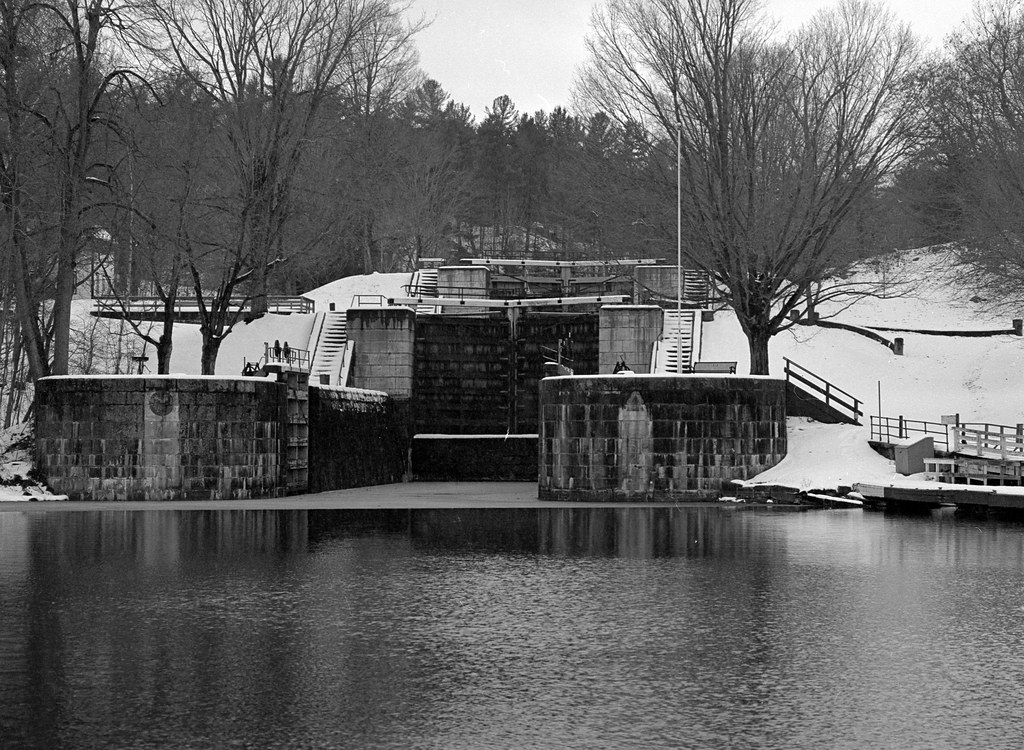
Mamiya m645 – Mamiya-Sekor C 150mm 1:3.5 N – Ilford HP5+ @ ASA-200 – Pyrocat-HD (1+1+100) 9:00 @ 20C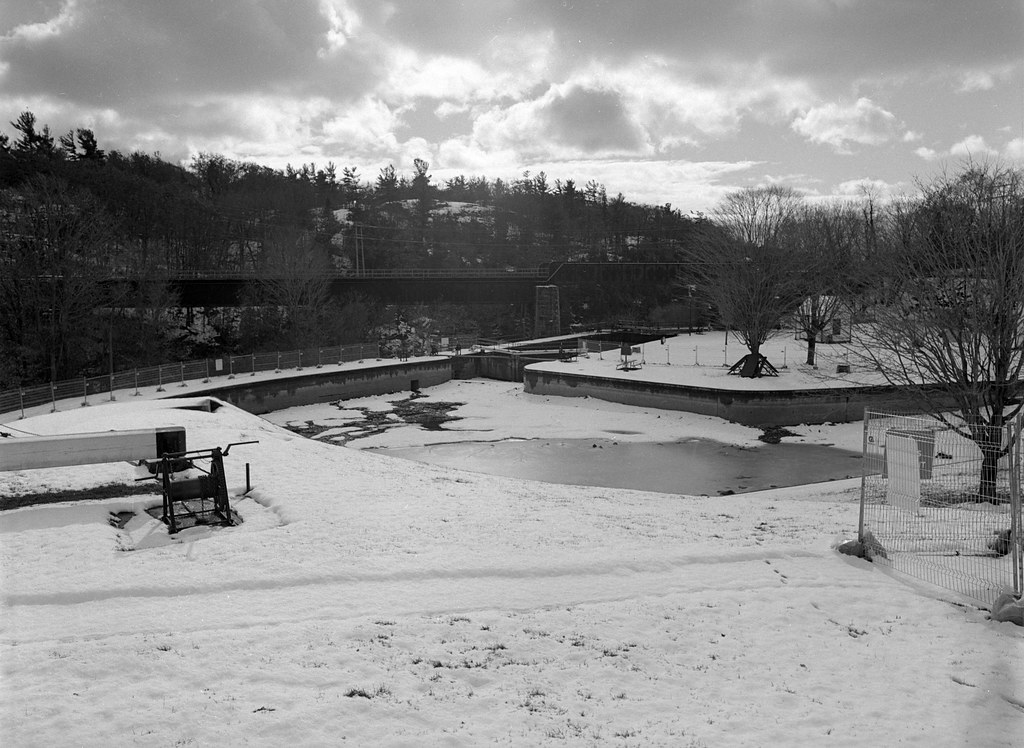
Mamiya m645 – Mamiya-Sekor C 150mm 1:3.5 N – Ilford HP5+ @ ASA-200 – Pyrocat-HD (1+1+100) 9:00 @ 20C
Taming nature proved a hard task. Construction moved at a brisk pace through 1827 without major incidents. The trouble came with an early thaw in 1828 causing an unexpected rise in the river water levels. The rise swept away the entire works at the Hogsback Falls Dam. Construction began again only to be washed aside a second time in April. By would appease Walter Fenlon, the contractor assigned to the Hogsback Locks and Dam, and took direct control over the construction using the military staff. They were able to work through the rest of the year and nearly have the dam completed, but a second harsh winter and early thaw in 1829 saw leaks again appear. Colonel By rushed to the site to investigate the leaks, arriving just in time. His journals recall he felt an earthquake before the dam broke apart. Giving time for By to raise the alarm, he was more concerned with the workers, than the work. No man would be lost as the Hogsback dam collapsed a third time. Rather than start again with the same technique, By and his engineers devised a floating dam using wooden coffers to give a better structure as the fitted stones were put in place. The change worked, and by the end of 1829, the Hogsback Dam saw completion. Hogsback is not the only engineering marvel on the Rideau Canal; the entire canal is a testament to the Engineering capabilities of the 19th-Century. The set of seven locks that up the flight locks at Bytown, and the four locks at flight locks at Jones Falls. Also at Jones Falls is the first fitted stone curved dam constructed in North America. It would be another year that the actual locks were completed across the entire waterway. Bytown had become a bustling community, as had other workcamps. Kingston Mills had a hundred buildings to its name. And many other communities had churches, schools, homes, hotels, and taverns. For the civilian contractors, the Rideau Project turned them a handsome profit. Redpath would use his cut to start a Sugar company that still bears his name, not to mention funding the construction of the Notre Dame Basilica and the first buildings of McGill University in Montreal. Thomas McKay would design Rideau Hall that stands today as the residence of the Governor-General. Robert Drummond went on to build a shipbuilding enterprise as well as became a brewery and mining magnate. And while the profit was good for the contractors, By continuing to be concerned over the ballooning cost of the project, yet his reports to London continued to be met with silence. So By continued, now focused on the defensive structures. Colonel By laid out the plans to have each lock guarded by a blockhouse, with Merrickville being the centre of the canal and its defences. Troops could continue to fall back to the larger than most blockhouse built there. Of course, that is if the enemy could get past the fortifications planned for Point Henry in Kingston and Barracks Hill in Bytown. Construction on the blockhouses commenced in 1832 along with the demolition of the War-Era fort at Kingston. The new forts were twins, based off the design of the Citadel at Quebec City and Halifax, and could resist both land and water assaults. Gone were earthworks and wooden blockhouses, replaced by limestone walls, casemates, and bristling with the latest in artillery. Little did Colonel By realise his triumph was about to crash down about his ears. It was on the 21st of May 1832 he, his family and officers boarded a steamship, the Rideau in Kingston to make a grand tour of the canal to open its service. It was on the 25th a message was dispatched from London to Bytown recalling Colonel By to answer for the massive cost overrun of the project. It was not the letter Colonel By had been expecting; he expected a promotion, a pension, maybe even a knighthood for his efforts. Instead, the letter stripped him of command, stop all construction work except that already being worked on, and he was to return to London.
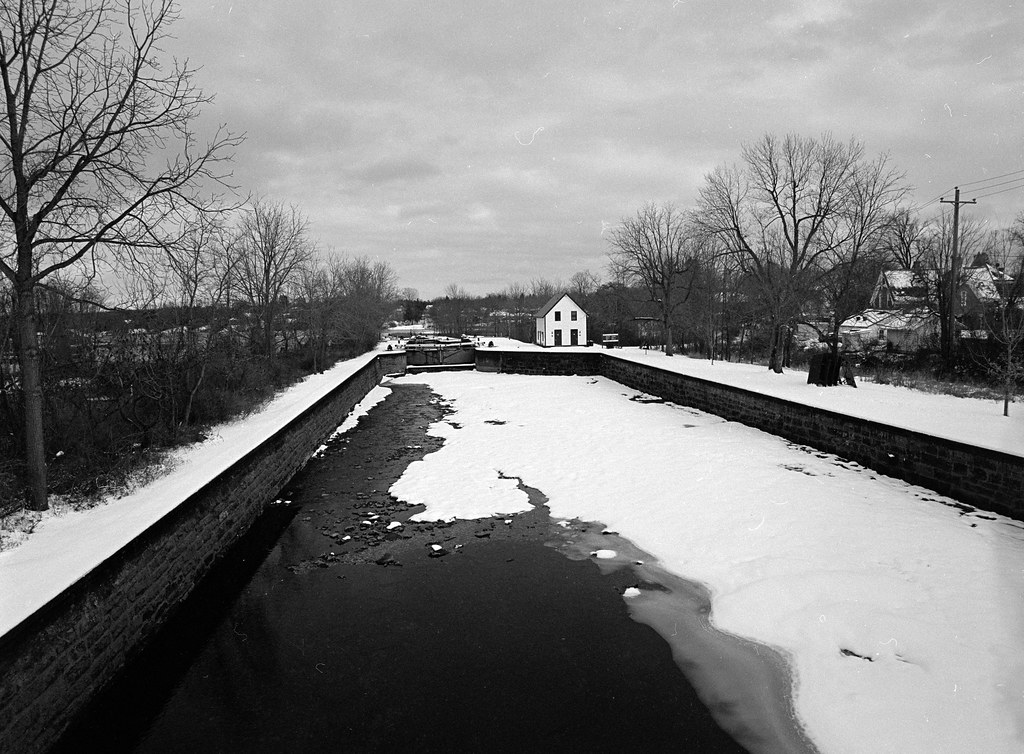
Mamiya m645 – Mamiya-Sekor C 35mm 1:3.5 N – Ilford HP5+ @ ASA-200 – Pyrocat-HD (1+1+100) 9:00 @ 20C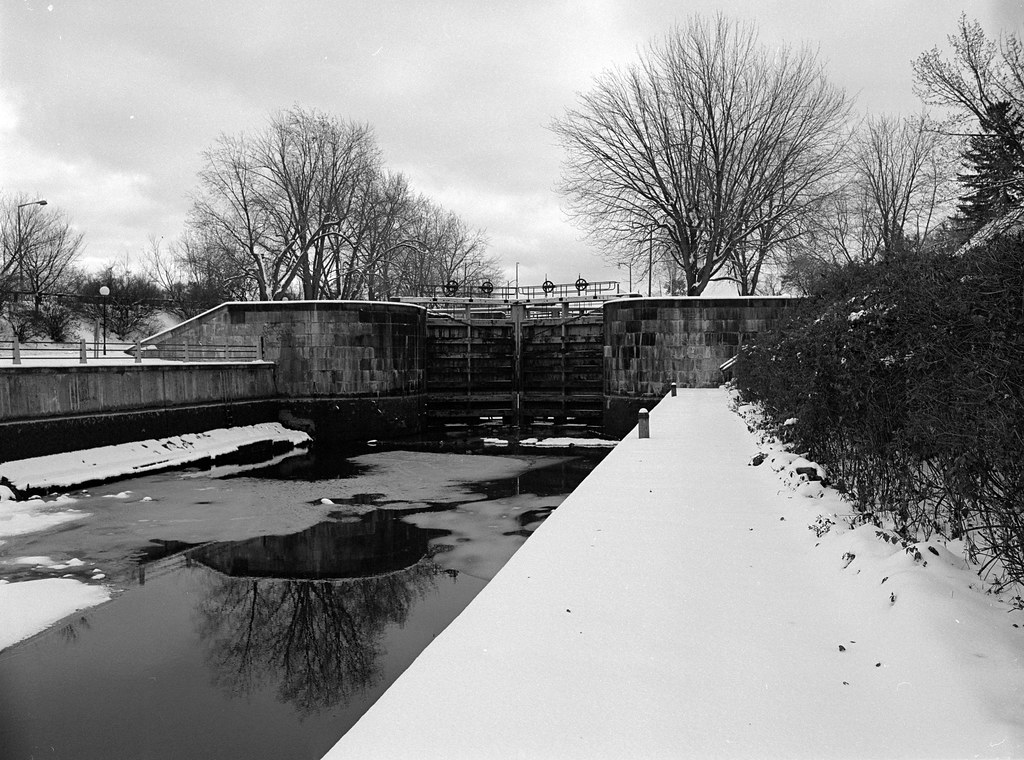
Mamiya m645 – Mamiya-Sekor C 45mm 1:2.8 N – Ilford HP5+ @ ASA-200 – Pyrocat-HD (1+1+100) 9:00 @ 20C
The fault was not By’s; the multiple hearings concluded that. By simply was a scapegoat in a political battle between Horse Guards, who had ordered By to complete the project no matter the cost, and the Parliament who was not pleased with the blank cheque. And while many stood by the Colonel, he would not receive any recognition from Parliament or the Crown; the optics were just not right. He returned to his retirement without fanfare and died a broken man in 1836. Four blockhouses were completed on the Rideau Canal; a fifth was stopped mid-construction and never completed. The new Fort Henry saw completion in 1837, the second fort was never started leaving only the barracks to sit on the hill above the canal. Those locks which did not get a blockhouse, a larger Lockmaster house was built which could be used as a defensive building if needed. Many who had come to Canada to work on the Canal stayed, living in the communities they helped build. Many in Miners & Sappers remained to man the locks, and various regiments stationed in Canada would garrison the canal. By 1841 the job of defending the canal fell to the Royal Canadian Rifle Regiment. And while the Canal never saw use as a military canal, it saw plenty of commercial traffic in the early years of operation, although as more locks were built along the St. Lawerence River commercial traffic slowed by 1849, with the canal serving only the communities along its route. Bytown changed names to Ottawa in 1855, and be named the capital of the United Province of Canada in 1857. Horse Guards divested itself of the Rideau Canal, selling it to the Province of Canada, but by this point, the canal had become more a local waterway for personal watercraft. With the selection of Ottawa as the Provincial Capital, construction on the new Parliament Buildings started in 1859, with Barracks Hill being selected as the location of the new buildings. Fort Henry would continue to operate under the British Army until their departure in 1870 and by the Canadian Militia until 1891. By 1900 the Canal had ceased to be a commercial waterway as the public built summer homes and boating clubs along the canal banks. A dedicated group of employees from the Government continued to operate the canal locks.

Mamiya m645 – Mamiya-Sekor C 45mm 1:2.8 N – Ilford HP5+ @ ASA-200 – Pyrocat-HD (1+1+100) 9:00 @ 20C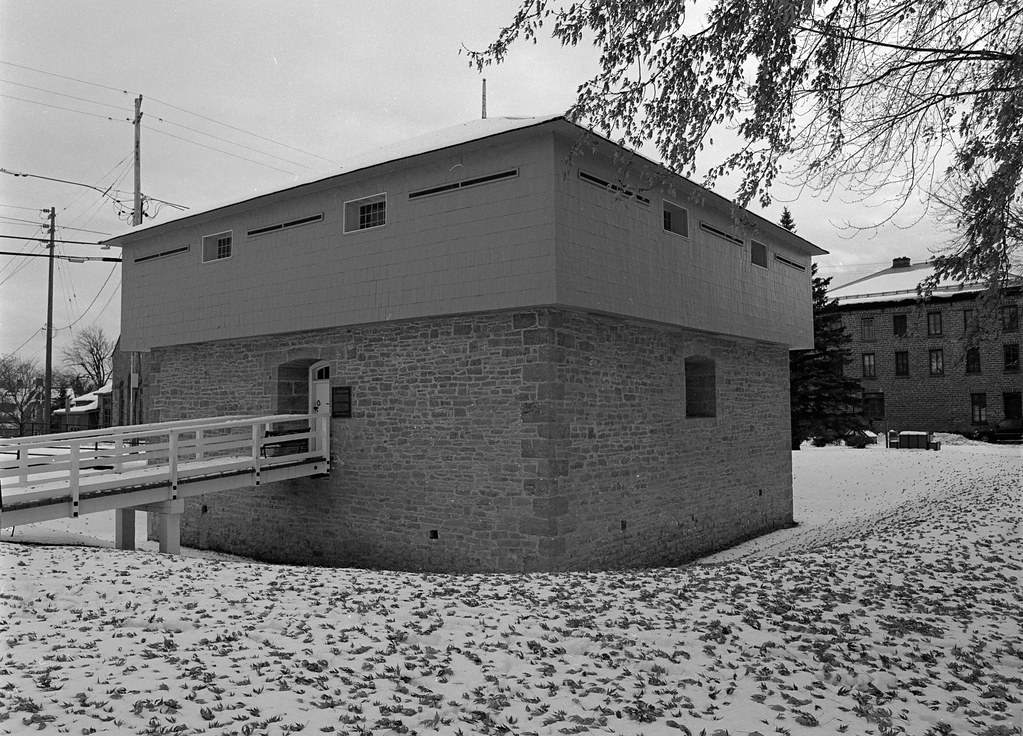
Mamiya m645 – Mamiya-Sekor C 45mm 1:2.8 N – Ilford HP5+ @ ASA-200 – Pyrocat-HD (1+1+100) 9:00 @ 20C
Mamiya m645 – Mamiya-Sekor C 45mm 1:2.8 N – Ilford HP5+ @ ASA-200 – Pyrocat-HD (1+1+100) 9:00 @ 20C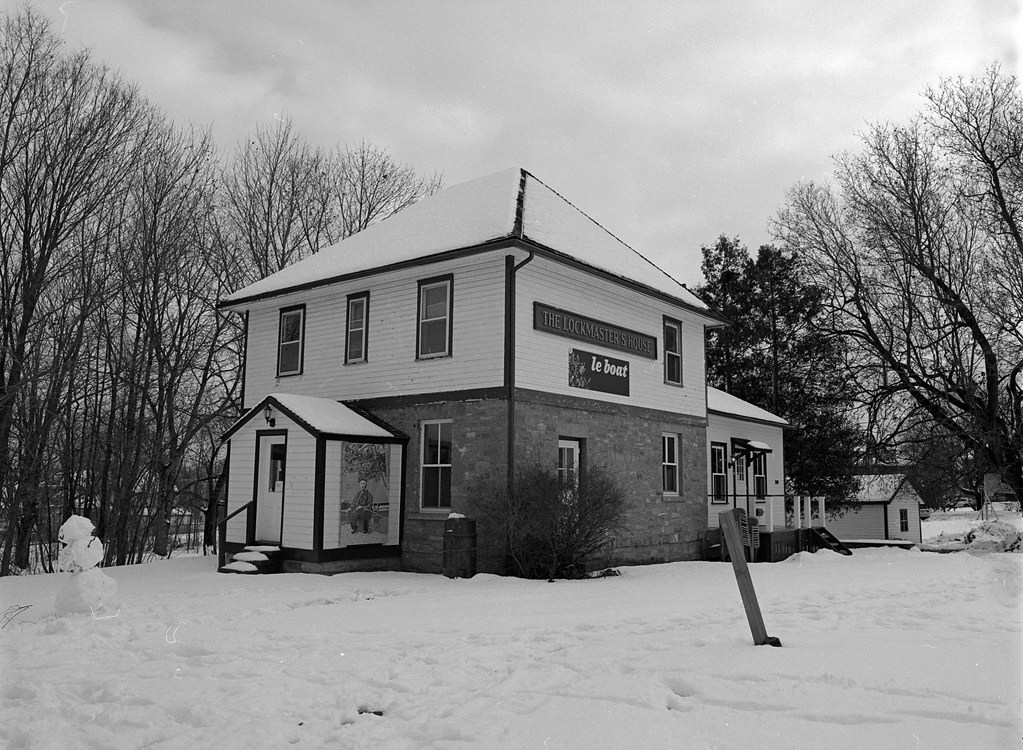
Mamiya m645 – Mamiya-Sekor C 45mm 1:2.8 N – Ilford HP5+ @ ASA-200 – Pyrocat-HD (1+1+100) 9:00 @ 20C
Fort Henry served during World War One not as a military post but as an internment camp for Canadians who were of German or Austrian descent. The Canal received a historical designation in 1995. Through the Great Depression, Fort Henry and many other colonial-era forts saw reconstruction under various make-work programs, and Fort Henry reopened as a living history museum in 1938. Although the fort shut down in World War Two as it became a Prisoner-Of-War camp for high-risk German officers, Parks Canada would take over control of the Rideau Canal in 1975, and started on a full restoration of the canal and its infrastructure, allowing the canal to reopen in 1982 for the 150th Anniversary of its construction. Both the Canal and Fort Henry received UNESCO World Heritage Status in 2007. Today the Canal still operates as it would have during its normal operation. Parks Canada Staff operates the canal locks throughout the Late Spring and into the Early Fall manually and offers full passage to personal water-craft. And the Canal remains a peek into how travel was done through Upper Canada in the 19th-Century. The four completed blockhouses have become local museums, with Merrickville being the main museum along the canal. Several historical plaques along the canal highlight its importance to the history and expansion of Canada in the pre-confederation days. The communities formed around the canal’s construction still thrive today as their communities or suburbs of larger ones. In Kingston, Fort Henry remains one of the city’s main tourist attractions, with the highlight being the Fort Henry Guard, an elite group of dedicated staff who portray Canadian Militia as they were in the 1860s. Showing off drill and tactics, often using original weapons, and operating the many guns displayed at the fort. The Commissariat Building still stands today in Ottawa and houses the Bytown Museum which tells the early history of the region. Recent construction on Parliament Hill has uncovered some remains of the old Barracks Hill complex, you can read more on the project and see some of the items found on the CBC. And as I mentioned at the beginning in Ottawa during the winter months, the Rideau through the downtown core becomes the world’s longest skateway, a completely Canadian experience if you’re into that activity. While Colonel John By received no recognition for his achievement, the fact his Canal still operates today his recognition enough, although a statue of John By stands still today overlooking the Ottawa Locks in Majors Hill Park.
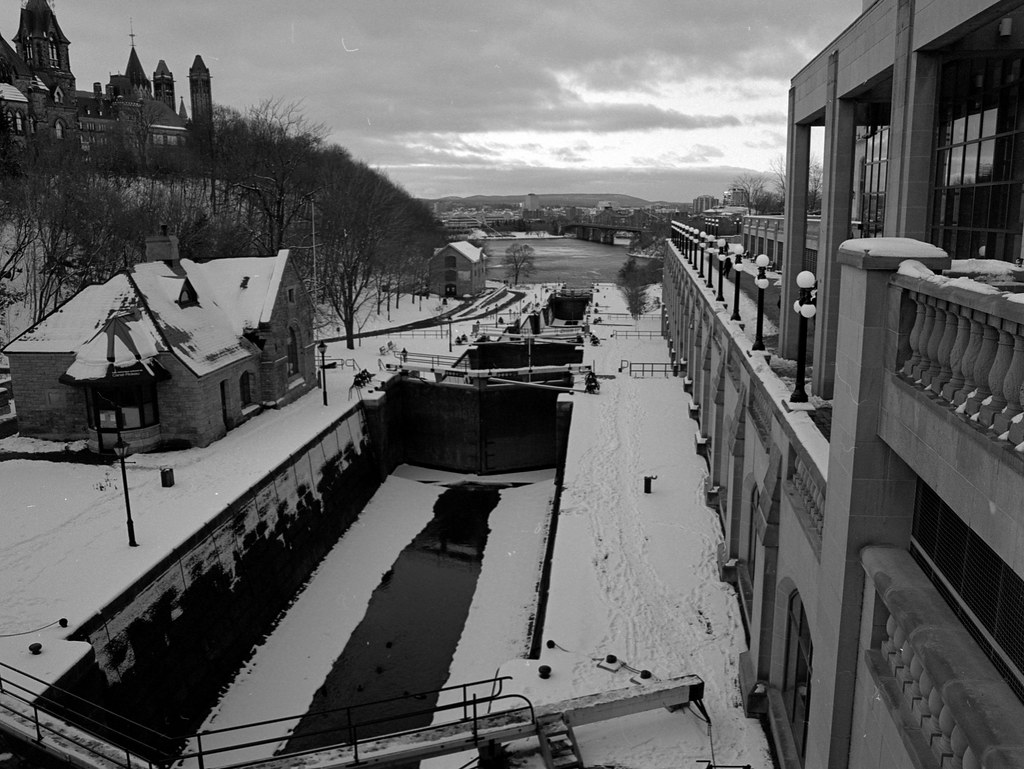
Mamiya m645 – Mamiya-Sekor C 45mm 1:2.8 N – Ilford HP5+ @ ASA-200 – Pyrocat-HD (1+1+100) 9:00 @ 20C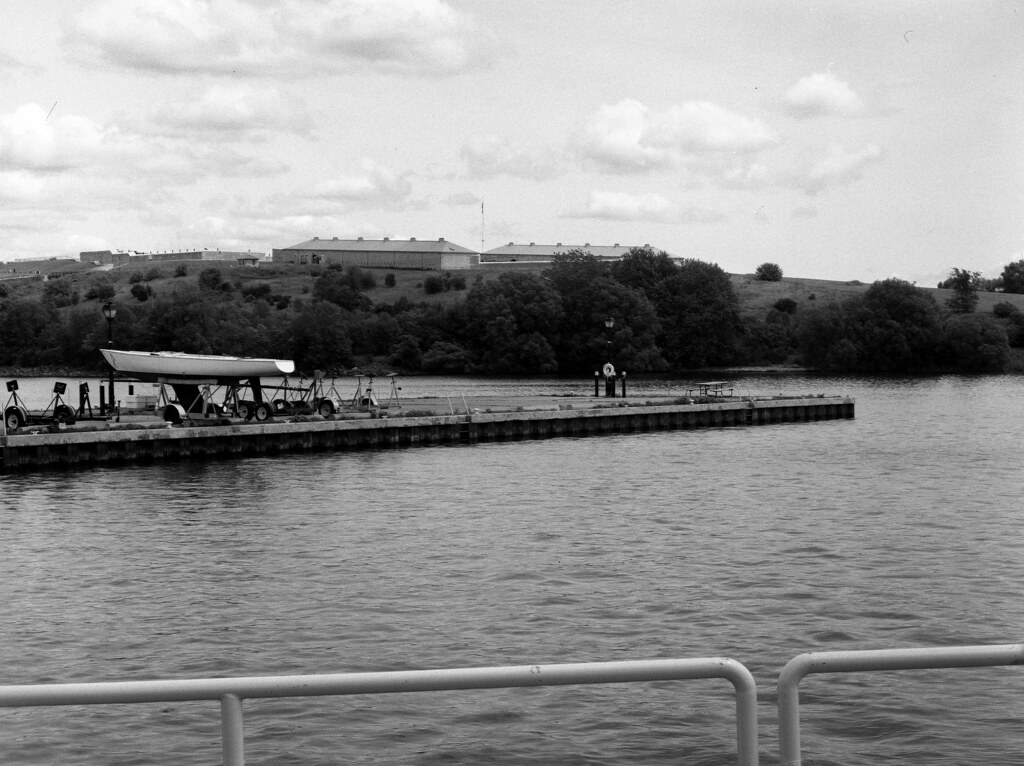
Anniversary Speed Graphic – Kodak Ektar f:7.7 203mm – Ilford HP5+ @ ASA-400 – Kodak HC-110 Dil. B 5:00 @ 20C